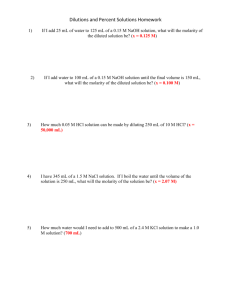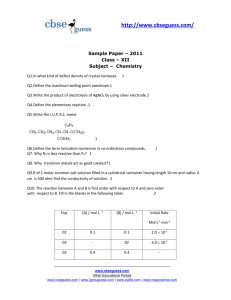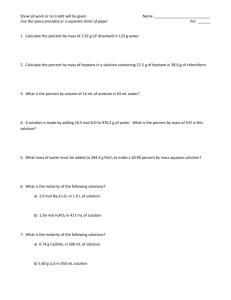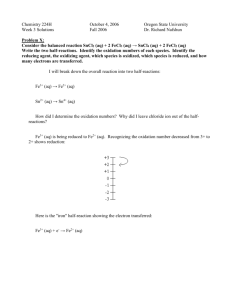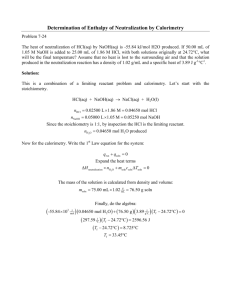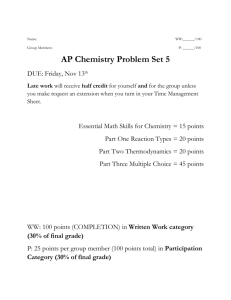Chapter 11 Reaction in Aqueous II: Calculation
advertisement
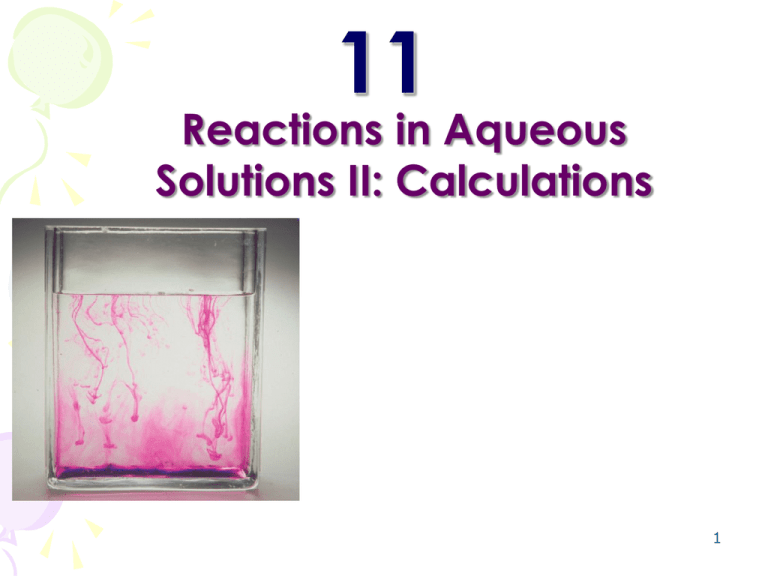
11 Reactions in Aqueous Solutions II: Calculations 1 Chapter Goals Aqueous Acid-Base Reactions 酸鹼中和反應 • • • Calculations Involving Molarity 有關體積莫耳濃度 的計算 Titrations 滴定 Calculations for Acid-Base Titrations 酸鹼滴定的計 算 Oxidation-Reduction Reactions 氧化還原反應 • • • Balancing Redox Equations 氧化還原方程式平衡 Adding in H+, OH- , or H2O to Balance Oxygen or Hydrogen Calculations for Redox Titrations 計算氧化反原滴定 2 Concentrations of Solutions • Second common unit of concentration: Molarity is defined as the number of moles of solute per literof solution. 體積莫耳濃度是指每公升溶液中所含 的溶質莫耳數 Molarity = M= Number of moles of solute Number of liters of solution moles L M= mmoles mL M x L = moles solute and M x mL = mmol solute 3 Calculations Involving Molarity • The reaction ratio is the relative number of moles of reactants and products shown in the balanced equation. H2SO4 + 2NaOH Na2SO4 + 2H2O 1mol 2mol 1mol 2mol Reaction ratio 1mol H2SO4 or 2mol NaOH 2mol NaOH 1mol H2SO4 4 Calculations Involving Molarity Example 11-1: Acid-Base Reactions If 100.0 mL of 1.00 M NaOH and 100.0 mL of 0.500 M H2SO4 solutions are mixed, what will the concentration of the resulting solution be? What is the balanced reaction? It is very important that we always use a balanced chemical reaction when doing stoichiometric calculations. 2NaOH+ H2SO4 Na2SO4 + 2H2O M=mole/liter mole= M x liter NaOH =1.00M x 0.1L =0.1 mole H2SO4 =0.500M x 0.1L =0.05 mole 5 Calculations Involving Molarity 2NaOH+ H2SO4 Na2SO4 + 2H2O Reaction Ratio 2 mol 1 mol Before Reaction 0.1 mol 0.05 mol After Reaction 0 mol 0 mol 1 mol 2 mol 0.05 mol 0.1 mol •What is the total volume of solution? 100.0 mL + 100.0 mL = 200.0 mL •What is the sodium sulfate amount, in mol? 0.05 mol • What is the molarity of the solution? M = 0.05 mol/0.2 L = 0.250 M Na2SO4 6 Calculations Involving Molarity Example 11-2: Acid-Base Reactions If 130.0 mL of 1.00 M KOH and 100.0 mL of 0.500 M H2SO4 solutions are mixed, what will be the concentration of KOH and K2SO4 in the resulting solution? What is the balanced reaction? 2 KOH+ H2SO4 K2SO4 + 2H2O M=mole/liter mole= M x liter KOH =1.00M x 0.130L =0.130 mole H2SO4 =0.500M x 0.1L =0.05 mole 7 2KOH+ H2SO4 K2SO4 + 2H2O Reaction Ratio 2 mol 1mol Before Reaction 0.130 mol 0.05 mol After Reaction 0.030 mol 0 mol 1 mol 2 mol 0.05 mol 0.1 mol •What is the total volume of solution? 130.0 mL + 100.0 mL = 230.0 mL •What are the potassium hydroxide and potassium sulfate amounts? 0.03 mol & 0.05 mol • What is the molarity of the solution? M = 0.03 mol/0.230 L = 0.130 M KOH M = 0.05 mol/0.230 L = 0.217 M K2SO4 8 Example 11-3: Acid-Base Reactions What volume of 0.750 M NaOH solution would be required to completely neutralize 100 mL of 0.250 M H3PO4? 3 NaOH+ H3PO4 Na3PO4 + 3H2O M=mol/liter mol= M x liter liter = mol/M ? mol H3PO4 =0.250M x 0.1L =0.025 mole complete neutralize need 0.025x3=0.075 mol NaOH ?L NaOH = 0.075 mol / 0.750M =0.10 L 9 Titrations滴定法 Acid-base Titration Terminology • Titration 滴定– A method of determining the concentration of one solution by reacting it with a solution of known concentration. • Primary standard 一級標準– A chemical compound which can be used to accurately determine the concentration of another solution. Examples include KHP and sodium carbonate 碳酸鈉. • Standard solution 標準溶液 – A solution whose concentration has been determined using a primary standard. • Standardization 標定– The process in which the concentration of a solution is determined by accurately measuring the volume of the solution required to react with a known amount of a primary standard. 一級標準:高純度物質 -做為參考物質。由一級標準滴定標 準溶液,以測定濃度的程序,稱為標定(standarddization)10 Titrations Acid-base Titration Terminology • Indicator 指示劑– A substance that exists in different forms with different colors depending on the concentration of the H+ in solution. Examples are phenolphthalein 酚酞 and bromothymol blue溴 百里酚藍. • Equivalence point當量點– The point at which stoichiometrically equivalent amounts of the acid and base have reacted. 酸與鹼當量數相等 • End point 滴定終點– The point at which the indicator changes color and the titration is stopped. bromothymol blue溴百里酚藍: Colorless in acidic 11 solution, reddish violet in basic solution Titrations Acid-base Titration Terminology 12 Calculations for Acid-Base Titrations •The properties of an ideal primary standard include the following: – It must not react with or absorb the components of the atmosphere, such as water vapor, oxygen, and carbon dioxide. 不能跟大氣中物質反應 – It must react according to one invariable reaction – It must have a high percentage of purity (高純度) – It should have a high formula weight to minimize the effect of error in weighing (大分子量) – It must be soluble in the solvent of interest – It should be nontoxic (無毒) – It should be readily available (inexpensive 較便宜) – It should be environmentally friendly 13 Calculations for Acid-Base Titrations • Potassium hydrogen phthalate苯二甲酸鹽緩 衝溶液is a very good primary standard. – It is often given the acronym, KHP. – KHP has a molar mass of 204.2 g/mol. 14 標準酸或鹼的選取 在標定酸或鹼的濃度時,常選用一些分子量較大純度高的酸 或鹼來做為滴定的標準品,如鄰苯二甲酸氫鉀 (potassium hydrogen phthalate,簡記為KHP)等,稱 之為一級標準品,可用以定量我們所配製鹼 (酸) 液之精 確濃度。 而經滴定測得精確濃度的標準鹼 (酸) 溶液,稱之為二級標準 鹼 (酸)。利用鄰苯二甲酸氫鉀以標定所配製之氫氧化鈉溶 液濃度。因KHP 為單質子酸 (monoprotic acid),與氫 氧化鈉為1:1 中和 (如式1),故利用此化學計量關係可求 出氫氧化鈉溶液的濃度。 HOOCC6H4COOK(aq) + NaOH(aq) → C6H4(COO-)2(aq)+ K+ + (aq) + Na (aq) + H2O(l) 15 •Example 11-4: Calculate the molarity of a NaOH solution if 27.3 mL of it reacts with 0.4084 g of KHP. NaOH + KHP NaKP +H2O ?mole NaOH = 0.4084 g KHP x 1 mol KHP x1 mol NaOH 1 mol KHP 204.2gKHP = 0.002 mol NaOH 0.002 mol NaOH = 0.0733 M NaOH ?M NaOH = 0.0273 L NaOH 16 • Example 11-5: Calculate the molarity of a sulfuric acid solution if 23.2 mL of it reacts with 0.212 g of Na2CO3. Na2CO3 + H2SO4 Na2SO4 + CO2 + H2O ?mole H2SO4 = 0.212 g Na2CO3 x 1 mol Na2CO3 x 1 mol H2SO4 1 mol Na2CO3 106g Na2CO3 = 0.002 mol H2SO4 ?M H2SO4 = 0.002 mol H2SO4 = 0.0862 M H SO 2 4 0.0232 L H2SO4 17 •Example 11-6: An impure sample of potassium hydrogen phthalate, KHP, had a mass of 0.884 g. It was dissolved in water and titrated with 31.5 mL of 0.100 M NaOH solution. Calculate the percent purity of the KHP sample. Molar mass of KHP is 204.2 g/mol. NaOH + KHP NaKP + H2O ?mole NaOH = 31.5x10-3L solution x 0.1 mol NaOH 1L solution = 0.00315 mol NaOH 1 mol KHP x 204.2g KHP ?g KHP = 0.00315mol NaOH x 1 mol KHP 1mol NaOH = 0.643g KHP g KHP 0.643g % KHP = g sample x 100% = 0.884g x 100% = 72.7% 18 Example 11-5: Standardization of an Acid Solution Calculate the molarity of a solution of H2SO4 if 40.0ml of the solution neutralizes 0.364g of Na2CO3? Na2CO3 + H2SO4 Na2SO4 + CO2 + H2O 1 mol Na2CO3 1 mol H2SO4 ?mole H2SO4= 0.364 g Na2CO3 x 106.0g Na2CO3 x 1 mol Na2CO3 = 0.00343 mol H2SO4 ?M H2SO4= 0.00343mol H2SO4 0.04 L = 0.0858 M H2SO4 Exercise 26 19 Example 11-6: Standardization of a Base Solution A 20.00-ml sample of a solution of NaOH reacts with 0.3641g of KHP. Calculate the molarity of the NaOH solution. NaOH + KHP NaKP +H2O ?mole NaOH = 0.3641 g KHP x 1 mol KHP x 1 mol NaOH 204.2g KHP 1 mol KHP = 0.001783 mol NaOH ?M NaOH= 0.001783mol NaOH 0.02 L = 0.08915 M NaOH Exercise 28 20 Example 11-7: Titration The titration of 36.7ml of a hydrochloric acid solution requires 43.2 ml of standard 0.236M sodium hydroxide solution for complete neutralization. What is the molarity of the HCl solution? HCl + NaOH NaCl +H2O 1 mol HCl ?mmole HCl = 43.2ml NaOH x0.236mmol NaOH x 1ml NaOH 1 mol NaOH = 10.2 mmol HCl ?M HCl= 10.2mmol HCl 36.7 mL = 0.278 M HCl 21 Example 11-8: Titration The titration of 36.7ml of a sulfuric acid solution requires 43.2 ml of standard 0.236M sodium hydroxide solution for complete neutralization. What is the molarity of the H2SO4 solution? H2SO4 +2 NaOH Na2SO4 +2 H2O 1 mol H2SO4 ?mmole H2SO4 = 43.2ml NaOH x0.236mmol NaOH x 1ml NaOH 2 mol NaOH = 5.1 mmol H2SO4 ?M H2SO4 = 5.1 mmol H2SO4 36.7 mL = 0.139 M H2SO4 Exercise 38 22 Example 11-9: Dtermination of Percent Acid Oxalic acid, (COOH)2, is used to remove rust stains and some ink stains from fabrics. A 0.1743-g sample of impure oxalic acid required 39.82 ml of 0.08915 M NaOH solution for complete neutralization. No acidic impurities were present. Calculate the percentage purity of the (COOH)2. (COOH)2 +2 NaOH Na2(COO)2 + 2H2O 1 mol (COOH)2 ?mole (COOH)2 = 0.03982L NaOH x 0.08915mol NaOH x 1L NaOH 2 mol NaOH = 0.001775 mol (COOH)2 ?g (COOH)2 = 0.001775 mole x 90.04g (COOH)2 1mol (COOH)2 = 0.1598g (COOH)2 0.1598g (COOH) % purity = 0.1743g sample 2 x 100% = 91.68% Exercise 38 23 Oxidation-Reduction Reactions • We have previously gone over the basic concepts of oxidation & reduction in Chapter 4. • Rules for assigning oxidation numbers were also introduced in Chapter 4. – Refresh your memory as necessary. • We shall learn to balance redox reactions using the half-reaction method. 24 Oxidation-Reduction Reactions: An Introduction • Oxidation is an increase in the oxidation number. 氧化反應為增加氧化數 – Corresponds to the loss of electrons (失去電子). • Reduction is a decrease in the oxidation number. 還原反應為氧化數減少 – Good mnemonic – reduction reduces the oxidation number. – Corresponds to the gain of electrons (得到電子) 25 Balancing Redox Reactions Half reaction method rules: 1. Write the unbalanced reaction. 2. Break the reaction into 2 half reactions: – One oxidation half-reaction and – One reduction half-reaction Each reaction must have complete formulas for molecules and ions. 3. Mass balance each half reaction by adding appropriate stoichiometric coefficients. To balance H and O we can add: H+ or H2O in acidic solutions. OH- or H2O in basic solutions. 26 Balancing Redox Reactions 4. Charge balance the half reactions by adding appropriate numbers of electrons. Electrons will be products in the oxidation halfreaction. Electrons will be reactants in the reduction half-reaction. 5. Multiply each half reaction by a number to make the number of electrons in the oxidation half-reaction equal to the number of electrons reduction half-reaction. 6. Add the two half reactions. 7. Eliminate any common terms and reduce coefficients to smallest whole numbers. 27 Example 11-12 Tin (II) ions are oxidized to tin (IV) by bromine. Use the half reaction method to write and balance the net ionic equation. Starting Reaction Sn2+ +Br2 Sn4+ + BrMass balance the half-reaction Sn2+ Sn4+ Charge balance the half reaction Add the two half-reaction Sn2+ Sn4+ + 2eSn2+ Sn4+ + 2eElectrons are products thus this Br2 + 2e- 2Bris the oxidation half-reaction Sn2+ +Br2 Sn4+ + 2BrMass balance the half-reaction Br2 2BrCharge balance the half reaction Br2 + 2e- 2BrThis is the reduction half-reaction 28 Example 11-13 Dichromate ions oxidize iron (II) ions to iron (III) ions and are reduced to chromium (III) ions in acidic solution. Write and balance the net ionic equation for the reaction. Starting Reaction 2- + Fe2+ Cr3+ + Fe3+ Cr2O+6 7 Mass balance the half-reaction Fe2+ Fe3+ Charge balance the half reaction Add the two half-reaction 2+ 3+ Fe Fe + e 6(Fe2+ Fe3+ + e-) This is the oxidation half-reaction 14H+ + Cr2O72- + 6e- Mass balance the half-reaction 3+ + 7H O 2Cr 2 Cr2O72- 2Cr3+ 2+ + 26Fe 14H + Cr2O7 Cr2O72- 2Cr3+ + 7H2O 3+ + 2Cr3+ + 7H O 6Fe + 23+ 2 14H + Cr2O7 2Cr + 7H2O Charge balance the half reaction 14H+ + Cr2O72-+ 6e- 2Cr3+ + 7H2O This is the reduction half-reaction 29 Example 11-14 In basic solution hydrogen peroxide oxidizes chromite ions, Cr(OH)4-, to chromate ions, CrO42-. The hydrogen peroxide is reduced to hydroxide ions. Write and balance the net ionic equation for this reaction. +3 Cr(OH)4- + H2O2 CrO42-+6 Basic solution Mass balance the half-reaction Cr(OH)4- + OH- CrO42Add the two half-reaction 2Cr(OH)4 + OH CrO4 + H2O 2 (Cr(OH) - + 4OH- CrO 2- + 4H O +3e-) 4 4 2 Cr(OH)4- + 4OH- CrO42- + 4H2O 3 (H O + 2e- 2OH-) 2 2 Charge balance the half reaction Cr(OH)4- + 4OH- CrO42- + 4H2O +3e- 2Cr(OH)4- +8OH- + 3H2O2 2CrO42- + 8H2O+ 6OH- oxidation half-reaction Mass balance the half-reaction 2Cr(OH) - +2OH- + 3H O 4 2 2 H2O2 2OH Charge balance the half reaction 2CrO42- + 8H2O H2O2 + 2e- 2OH- reduction half-reaction 30 Example 11-15 When chlorine is bubbled into basic solution, it forms hypochlorite ions and chloride ions. Write and balance the net ionic equation. This is a disproportionation redox reaction. The same species, in this case Cl2, is both reduced and oxidized. - +ClCl+0 ClO 2 +1 Basic solution Mass balance the half-reaction Cl2 + 4OH- 2ClO- +2H2O Add the two half-reaction Charge balance the half reaction Cl + 4OH- 2ClO- + 2H O +2e2 2 Cl2 + 4OH 2ClO +2H2O+2e oxidation half-reaction Mass balance the half-reaction Cl2 2Cl- Cl2 + 2e- 2Cl- 2Cl2 + 4OH- 2ClO- + 2Cl-+ 2H2O Cl2 + 2OH- ClO- + Cl-+ H2O Charge balance the half reaction Cl2 + 2e- 2Cl- reduction half-reaction Disproportionation Reaction 不均化反應 is a redox reaction in which the same element is oxidized and reduced. 31 Concentrations of Solutions • Second common unit of concentration: Molarity is defined as the number of moles of solute per literof solution. Number of moles of solute Molarity = Number of liters of solution moles M= L mmoles M= mL M x L = moles solute and M x mL = mmol solute 32 Example 11-16 What volume of 0.200 M KMnO4 is required to oxidize 35.0 mL of 0.150 M HCl? The balanced reaction is: 2KMnO4 + 16HCl 2KCl + 2MnCl2+ 5Cl2+ 8H2O ?mmole HCl = 35ml solution x 0.150M = 5.25 mmol HCl 2 mmol KMnO ?mmol KMnO4 = 5.25 mmol HCl x 16mmol HCl 4 = 0.656 mmol KMnO4 1mL ? ml KMnO4 = 0.656 mmol KMnO4 x 0.20mmol KMnO 4 = 3.28ml KMnO4 33 Example 11-17 A volume of 40.0 mL of iron (II) sulfate is oxidized to iron (III) by 20.0 mL of 0.100 M potassium dichromate solution. What is the concentration of the iron (II) sulfate solution? From Example 11-19 the balanced equation is: 6Fe2+ 14H+ + Cr2O72- 6Fe3+ + 2Cr3+ + 7H2O ?mmole Cr2O72- = 20.0ml solution x 0.100M = 2.00 mmol Cr2O726 mmol Fe2+ 2+ 2?mmol Fe = 2.00 mmol Cr2O7 x 1mmol Cr O 22 7 2+ = 12.0 mmol Fe 1M 2+ ? M Fe = 12.0 mmol KMnO4 x 40.0mmol KMnO 4 = 0.30 M Fe2+ 34 Example 11-10: Balancing Redox Equations A useful analytical procedure involves the oxidation of iodide to free iodine. The free iodine is then titrated with a standard solution of sodium thiosulfate, Na2S2O3. Iodine oxidizes S2O32- ions to tetrathionate ions, S4O62- and is reduced to I- ions. Write the balanced net ionic equation for this reaction. Starting Reaction I2 + S2O32- I-+ S4O62balance the ox. half-reaction Add the two half-reaction S2O32- S4O622 S2O32- S4O62-+ 2e2 S2O32- S4O62I2 + 2e- 2 I2 S2O32- S4O62-+ 2ebalance the red. half-reaction I2 + 2S2O32- 2I-+ S4O62I2 II2 2II2 + 2e- 2 IExercise 38 35 Example 11-11: Net Ionic Equations Permanganate ions oxidize ion(II) to iron(III) in sulfuric acid solution. Permanganate ions are reduced to manganese(II) ions. Write the balanced net ionic equation for this reaction. Starting Reaction Fe2+ + MnO4- Fe3++ Mn2+ balance the ox. half-reaction Add the two half-reaction 5 (Fe2+ Fe3++ e- ) Fe2+ Fe3+ - + 8H++ 5e- Mn2++ 4H O 2+ 3+ MnO 4 2 Fe Fe + e 5Fe2+ +MnO4- + 8H+ balance the red. half-reaction 5Fe3+ +Mn2++ 4H2O MnO4- Mn2+ MnO4- + 8H+ Mn2++ 4H2O MnO4- + 8H++ 5e- Mn2++ 4H2O Exercise 38 36 Example 11-13: Balancing Redox equations In basic solution, hypochlorite ions, ClO-, oxidize chromite ions, CrO2-, to chromate ions, CrO42-, and are reduced to chloride ions. Write the balanced net ionic equation for this reaction. Starting Reaction ClO- + CrO2- Cl-+ CrO2- balance the ox. half-reaction CrO2- CrO2CrO2- + 4OH- CrO42- + 2H2O CrO2- + 4OH- CrO42- + 2H2O + 3e- Add the two half-reaction 2(CrO2- + 4OH- CrO42- + 2H2O + 3e-) 3(ClO- + H2O+ 2e- Cl-+ 2OH-) 2CrO2- + 8OH- + 3ClO- + 3H2O 2CrO42- + 4H2O + 3Cl-+ 6OH- balance the red. half-reaction ClO- Cl- + 2OH- + 3ClO- 2CrO 2 ClO + H2O Cl + 2OH 2- + H O + 3Cl2CrO 4 2 ClO + H2O+ 2e Cl + 2OH Exercise 54 37 Example 11-14: Redox Titration What volume of 0.0200 M KMnO4 solution is required to oxidize 40.0ml of 0.100M FeSO4 in sulfuric acid solution? MnO4- + 8H+ + 5Fe2+ 5Fe3+ + Mn2+ + 4H2O ?mmol Fe2+ = 40.0ml solution x 0.100M = 4.00 mmol Fe2+ 1 mmol MnO42+ ?mmol MnO4 = 4.00 mmol Fe x 5mmol Fe2+ = 0.8 mmol MnO41ml ? ml KMnO4 = 0.8 mmol KMnO4 x 0.02mmol KMnO 4 = 40.0 ml KMnO4 Exercise 54 38 Example 11-15: Redox Titration A 20.00 ml sample of Na2SO3 was titrated with 36.30 ml of 0.5130 M K2Cr2O7 solution in the presence of H2SO4 solution. Calculate the molarity of the Na2SO3 solution. 3SO32- + Cr2O72- + 8H+ 3SO42- + 2Cr3+ + 4H2O ?mmol Cr2O72- = 36.30ml solution x 0.5130M = 1.862 mmol Cr2O7223 mmol SO ?mmol SO32- = 1.862 mmol Cr2O72- x 1mmol Cr O3 22 7 2= 5.586 mmol SO3 ? M Na2SO3 = 5.586 mmol Na2SO3 / 20ml Na2SO3 =0.2793 M Na2SO3 Exercise 66 39
